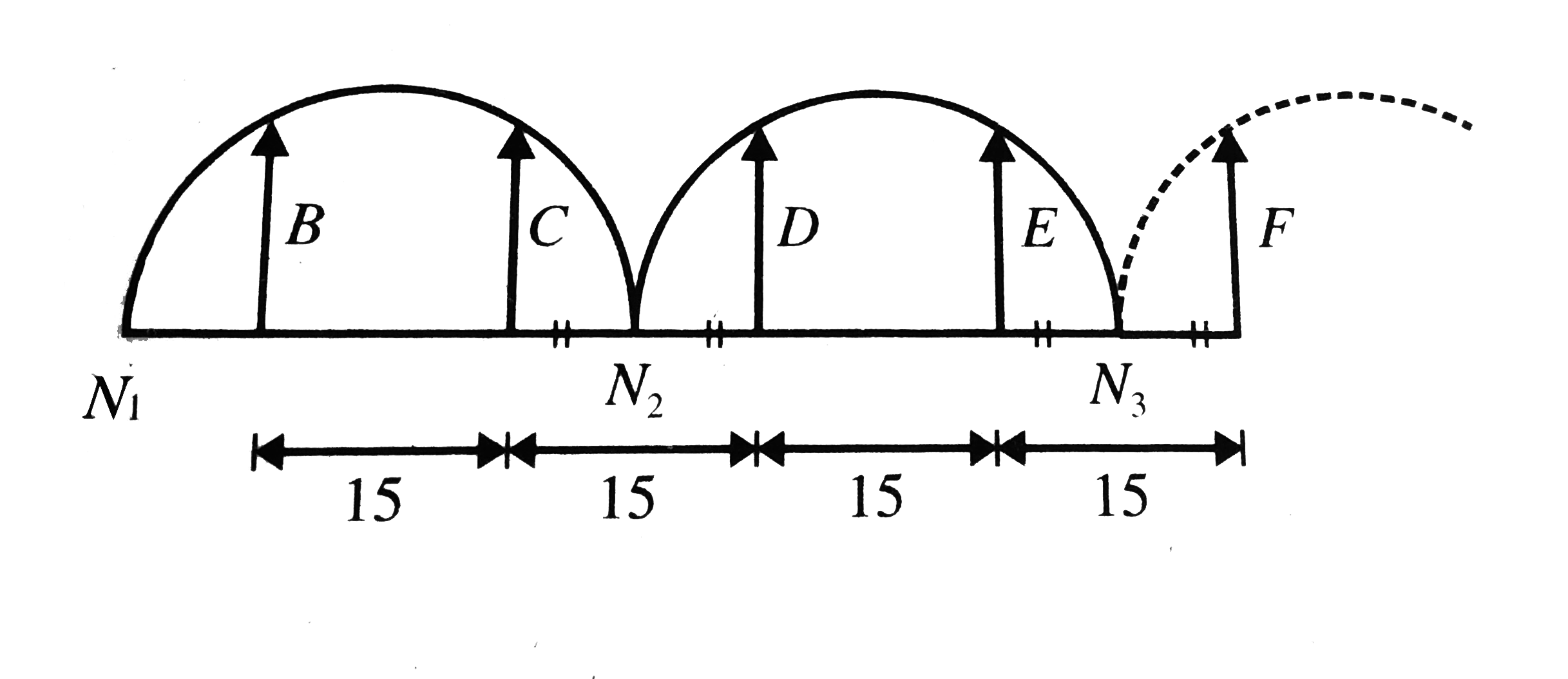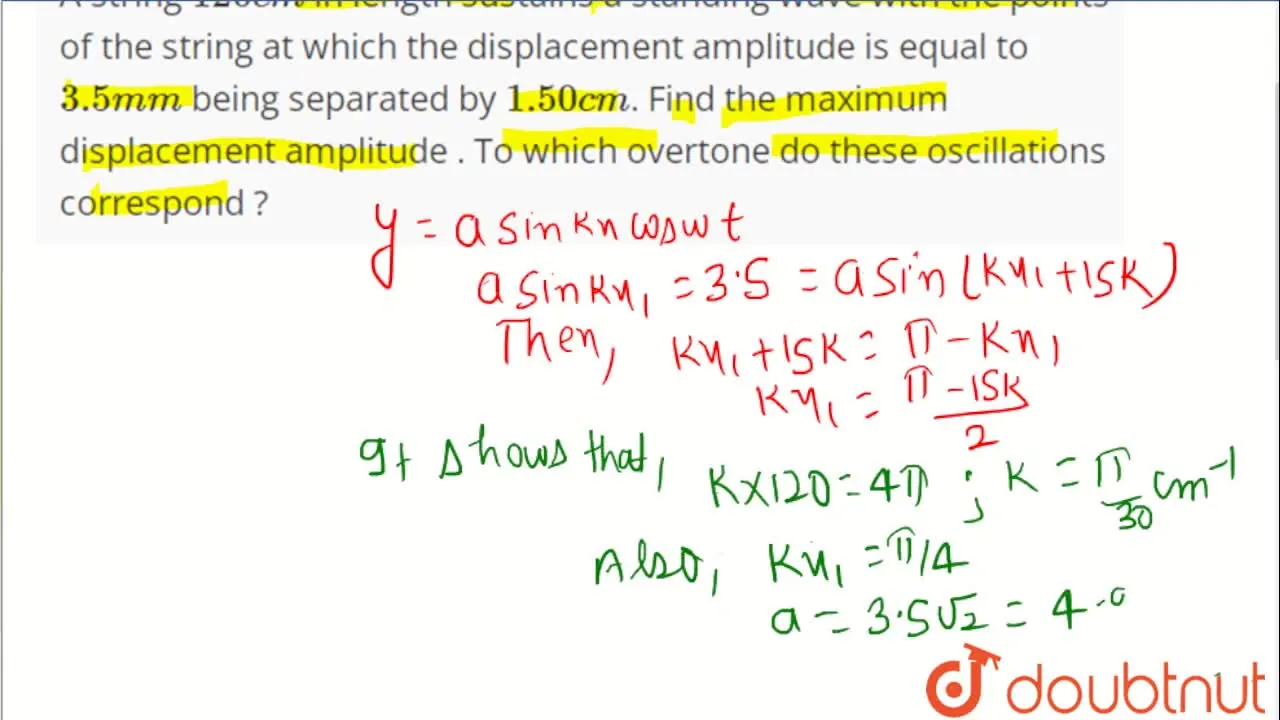A string 120cm in length sustains a standing wave with the points of the string at which the displacement amplitude is equal to 3.5mm being separated by 1.50cm. Find the maximum displacement amplitude . To which overtone do these oscillations correspond ?
When astring fixed at both the ensds sustains a standing wave , there are n (a whole number) segments of the length of the string , where particles in each segment of the string oscillate in phase with each other and are out of phase with the particles of the adjacent segment , the string contain n loops between its ends . Under this condition the amplitude of the oscillation varies from the point to point on the string as a harmonic function ( a sine function or a cosine function ). A typical equation for the standing wave can be given as y=ymaxsinkxcosωt.
Let the string be lying along the x - axis between x=0 and x=120cm. Let the amplitude variation along the length of the string be given by a=amaxsinkx , where k is the propagation constant.
First Method : (k=ωv=2πλ)
Let the string be oscillating in its nth harmonic . The string will constant n loops with end points as node . The points in a loop , where the displacement amplitudes are 3.5mm will be located symmetrically about antinode , as shown in the Fig . 7.37.
Now BC=DE=...=15cmandCD=EF=...=15cmcm ( A sine function given by y=sinx(0≤x≤π) is symmetrical about x=π/2, etc.)
CD=CN2+N2D
=(1202n−7.5)+(1202n−7.5)=2(1202n−7.5)
THus , 2(1202n−7.5)=15orn=4
The oscillations corresponds to the 4th harmonic ( the 3rd overtone ). The atring will oscillate in 4 loops . There are a total of 5 nodes ( including the nodes on the end of the next node the distance is λ/2 , the length of the string l=4λ/2 .
or λ/2=l/4=30cmorλ=60cm
k=2πλ=π30
Amplitude as function of x is
a=amaxsinkx=amaxsin(πx30)
Now at x=7.5,12.5cm,a=3.5mm
or 3.5=amaxsin(7.5π30)
or 3.5=amaxsin(π)4=amax√2
amax=3.5√2=4.935=5mm
Second Method : Suppose that the points shown in Fig . 7.38 represent the points which have equal amplitudes and are equally spaces . Now , distance two consecutives nodes is λ/2 . Therefore ,
a+b+c=λ/2 (i)
From symmetry considerations
a=c=d (ii)
Now , for such points to be equidistant throughout the string ,
b=c+d (iii)
From Eqs. (ii) and (iii),
b=2a
From Eq. (i) , we get
a+2a+a=λ/2
or a=λ/8 (iv)
b=2a=λ/4. The points where displacement amplitudes are 3.5mm are λ/4 apart.
∴λ/4=15orλ=60cm
Hence , a=λ/8=7.5cm
[ Note that only one value for b , i.e., distance between to such consecutive points exist , hence only one such set of points exist on the string and such points are λ/4 apart ]
No. of loops =2Lλ=2×12060=4
The string is in the 4th harmonic or 3rd overtone .


Similar Questions
A string 120cm in length sustains a standing wave, with the points of the string at which the displacement amplitude is equal to 3.5mm being separated by 15.0cm. Find the maximum displacement amplitude. To which overtone do these oscillations correspond ?
View SolutionA string 120 cm in length sustains standing wave with the points of the string at which the displacement amplitude is equal to 3.5 mm being separated by 15.0 cm. The maximum displacement amplitude is X. 95 mm then find out the value of X.
View SolutionA standing wave exists in string of length 150 cm fixed at both ends. The displacement amplitude of a point at a distance of 10 cm from one of ends if 5√3mm. The distance between two nearest points, within the same loop having the same displacement amplitude of 5√3 is 10 nm.
The maximum displacement amplitude of the particle in the string is,:View SolutionWhat is the displacement of a SHM particle of amplitude 3 cm, where its velocity is 13 of its maximum velocity ?
View SolutionA point isotropic source generates sound oscillations with frequency v=1.45kHz. At a distance r0=5.0m from the source the displacement amplitude of particles of the medium is equal to the a0=50μm, and at the point A located at a distance r=10.0m from the source the displacement ampitude is η=3.0 times less than a0 . Find :
(a) the damping coefficient γ of the wave,
(b0 the velocity oscillation amplitude of particles of the medium at the point A.View SolutionA string of mass 0.2 kg/m and length l= 0.6 m is fixed at both ends and stretched such that it has a tension of 80 N. The string vibrates in 3 segments with maximum amplitude of 0.5 cm. the maximum transverse velocity amplitude is
View SolutionStanding waves are set up in a string of length 240 cm clamped hiorizontatly at both ends. The separation between any two consecutive points where displacement amplitude is 3√2cm is 20cm. The standing waves were set by two travelling waves of equal amplitude of 3cm. The overtone in which the string is vibrating will be
View SolutionA standing wave is created on a string of length 120m and it is vibrating in 6th harmonic. Maximum possible amplitude of any particle is 10cm and maximum possible velocity will be 10cm/s. Choose the correct statement.
View SolutionA wave travelling on a string at a speed of 10ms−1 causes each particle of the string to oscillate with a time period of 20 ms. (a) What is the wavelength of the wave ? (b) If the displacement of a particle is 1.5 mm at a certain instant, what will be the displacement of a particle 10 cm away from it at the same instant ?
View SolutionA thin taut string tied at both ends and oscillating in its third harmonic has its shape described by the equation y(x,t)=(5.60cm)sin[(0.0340radcm)x]sin[(50.0rads)t], where the origin is at the left end of the string, the x-axis is along the string and the y-axis is perpendicular to the string.
(a) Draw a sketch that shows the standing wave pattern.
(b)Find the amplitude of the two travelling waves that make up this standing wave.
(c) What is the length of the string?
(d) Find the wavelength, frequency, period and speed of the travelling wave.
(e) Find the maximum transverse speed of a point on the string.
(f) What would be the equation y(x,t) for this string if it were vibrating in its eighth harmonic?View Solution


